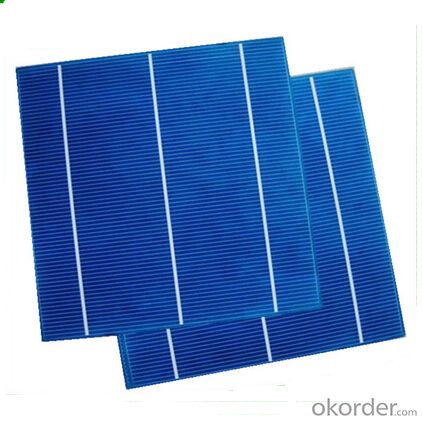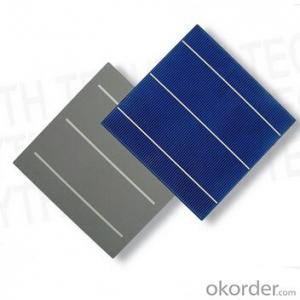Polycrystalline Solar Cells Series- C-16.80%
- Loading Port:
- Shanghai
- Payment Terms:
- TT OR LC
- Min Order Qty:
- 3000 pc
- Supply Capability:
- 300000 pc/month
OKorder Service Pledge
OKorder Financial Service
You Might Also Like
Solar Cells:
Solar cells is made by solar wafer, it has three categories of solar cell right now, monocrystalline polycrystalline and thin film,These cells are entirely based around the concept PN junction, which is the critical part of solar module, it is the part that can convert the light energy into electricity, the thickness is from 180um to 200um, with even busbars to conduct electricity, textured cell can decrease diffuse reflection; they are often electrically connected and encapsulated as a module. Photovoltaic modules often have a sheet of glass on the front (sun up) side, allowing light to pass while protecting semiconductor wafers from abrasion and impact due to wind-driven debris, rain, hail, etc. Solar cells are also usually connected in series in modules, creating an additive voltage. Connecting cells in parallel will yield a higher current;With high quality and stable quality. Our Cells can greatly improve the performance of Solar Modules.
Features:
1. High conversion efficiencies resulting in superior power output performance.
2. Outstanding power output even in low light or high temperature conditions
3. Optimized design for ease of soldering and lamination
4. Long-term stability, reliability and performance
5. Low breakage rate
Solar Cells Advantage:
• High efficiency and stable performance in photovoltaic conversion.
• Advanced diffusion technique ensuring the homogeneity of energy conversion efficiency of the cell.
• Advanced PECVD film forming, providing a dark blue silicon nitride anti-reflection film of homogenous color and attractive appearance.
• High quality metal paste for back surface and electrode, ensuring good conductivity, high pulling strength and ease of soldering.
• High precision patterning using screen printing, ensuring accurate busbar location for ease with automatic soldering a laser cutting.
Specifications:
Kit content:
Product: multicrystalline cell based on poly silicone
Format: 156 x 156mm ± 0.5mm
Front contacts (-): 3*1.5mm wide bus bars (silver), acid texturized surface, blue silicone nitride antireflection coating
Back contacts (+): 3*3mm wide bus bars (silver/aluminum), aluminum backside metallization
Warranty:
Repairs: For repairs please contact to us
Exchange service: You can choose between a refund, exchange or credit where goods are faulty or doesn’t do what it’s supposed to do
| Model | C16.80% |
| Max power | 2W |
| Short-circuit current (Isc) | 4.205A |
| Imax at 0.5V | 4A |
| Open circuit voltage (Voc) | 0.62V |
| Size | 156*78mm |
| Efficiency | 16.80% |

FAQ
We have organized several common questions for our clients,may help you sincerely:
1. What’s price per watt?
A: It’s depends on the quantity, delivery date and payment terms of the order. We can talk further about the detail price issue. Our products is high quality with lower price level.
2. Can you tell me the parameter of your solar cells?
We have different series of cells with different power output, both from c-si to a-si. Please take our specification sheet for your reference.
3. How do you pack your products?
We have rich experience on how to pack the panels to make sure the safety on shipment when it arrives at the destination.
4. Can you do OEM for us?
Yes, we can.
5. How long can we receive the product after purchase?
In the purchase of product within three working days, We will arrange the factory delivery as soon as possible. The perfect time of receiving is related to the state and position of customers. Commonly 7 to 10 working days can be served.
- Q:What is the history of solar cell development?
- The history of solar cell development dates back to the 19th century when French physicist Alexandre-Edmond Becquerel discovered the photovoltaic effect, which is the basis for solar cell technology. However, it was not until the 1950s that the first practical solar cells were developed, primarily for use in space exploration. Over the years, advancements in materials and manufacturing techniques have led to improved efficiency and affordability of solar cells. Today, solar cells are widely used to generate clean and renewable energy for various applications, ranging from powering homes and buildings to providing electricity in remote areas. Ongoing research and development continue to push the boundaries of solar cell technology, aiming to enhance efficiency, durability, and accessibility to harness the sun's energy more effectively.
- Q:Can solar cells be used in residential homes?
- Yes, solar cells can be used in residential homes. They are a sustainable and renewable energy source that can generate electricity by converting sunlight into usable energy. Installing solar panels on residential rooftops allows homeowners to generate their own clean energy and reduce their reliance on traditional fossil fuel-based electricity.
- Q:Where can I buy solar cells on sale but still good quality ?
- This is what I found on alibaba, The solar cells for Sale are 40 NEW, solar cells that are 3"x 6" each. PLUS Tabbing, Bus, Flux and a Diode. Great experience to build your own solar panel and save a lot of money.
- Q:Can solar cells be used on road surfaces?
- Yes, solar cells can be used on road surfaces. Solar roadways or solar panels embedded within road surfaces are being developed to generate clean and renewable energy. These solar cells can capture sunlight and convert it into electricity, which can be used to power streetlights, traffic signals, or even charge electric vehicles. However, the technology is still in its early stages and faces practical challenges such as durability and cost-effectiveness.
- Q:Can solar cells be used in agricultural farms?
- Yes, solar cells can be used in agricultural farms. Solar energy can be harnessed through solar panels to power various farm operations, such as irrigation systems, lighting, and equipment. This can help reduce reliance on fossil fuels, decrease energy costs, and promote sustainable practices in agriculture.
- Q:What is the window material in the solar cell? what's the effect?
- Because the window layer near the surface, the defect is very much, if the absorption of light generated photogenerated carriers, then it is easy to die, do not contribute to the battery output, the absorption of light are wasted, reducing battery efficiency.
- Q:How do solar cells perform in areas with high levels of dust?
- Solar cells can be affected by high levels of dust in areas. The accumulation of dust on the surface of solar cells can reduce their efficiency by blocking sunlight and reducing the amount of energy they can generate. Regular cleaning and maintenance are required to ensure optimal performance in dusty environments.
- Q:How do solar cells affect air pollution?
- Solar cells help reduce air pollution by producing electricity without emitting harmful pollutants or greenhouse gases. Traditional energy sources such as coal, oil, and gas power plants release pollutants like sulfur dioxide, nitrogen oxide, and carbon dioxide, contributing to air pollution and climate change. Solar cells, on the other hand, convert sunlight directly into electricity, generating clean and renewable energy. This reduces the need for fossil fuel-based electricity generation, thereby reducing air pollution and improving air quality.
- Q:Can solar cells generate power at night?
- No, solar cells cannot generate power at night as they rely on sunlight to produce electricity.
- Q:What is the size and weight of a typical solar cell?
- The size and weight of a typical solar cell can vary depending on its intended application and technology. However, a standard silicon-based solar cell is typically square-shaped with dimensions ranging from a few centimeters to around 15 centimeters on each side. In terms of weight, most solar cells are quite lightweight, typically weighing between a few grams to around 100 grams, depending on the size and material used.
1. Manufacturer Overview |
|
|---|---|
| Location | |
| Year Established | |
| Annual Output Value | |
| Main Markets | |
| Company Certifications | |
2. Manufacturer Certificates |
|
|---|---|
| a) Certification Name | |
| Range | |
| Reference | |
| Validity Period | |
3. Manufacturer Capability |
|
|---|---|
| a)Trade Capacity | |
| Nearest Port | |
| Export Percentage | |
| No.of Employees in Trade Department | |
| Language Spoken: | |
| b)Factory Information | |
| Factory Size: | |
| No. of Production Lines | |
| Contract Manufacturing | |
| Product Price Range | |
Send your message to us
Polycrystalline Solar Cells Series- C-16.80%
- Loading Port:
- Shanghai
- Payment Terms:
- TT OR LC
- Min Order Qty:
- 3000 pc
- Supply Capability:
- 300000 pc/month
OKorder Service Pledge
OKorder Financial Service
Similar products
New products
Hot products
Related keywords



























